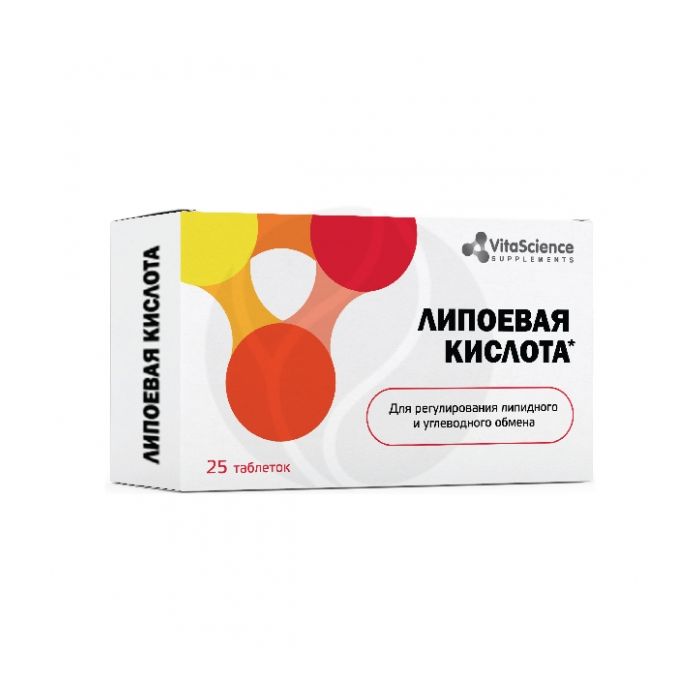Lipoic acid tablets 30mg dietary supplement, No. 25
Expiration Date: 05/2027
Russian Pharmacy name:
Липоевая кислота таблетки БАД 30мг, №25
fatty degeneration of the liver,
cirrhosis of the liver,
chronic hepatitis,
hepatitis A,
intoxication (including heavy metal salts, pale toadstool),
hyperlipidemia (including leading to the development of coronary atherosclerosis - treatment and prevention).
Treatment of liver diseases and intoxication:
inside, adults - 50 mg 3-4 times a day.
Children over 6 years old - 12-24 mg 2-3 times a day. The course of treatment is 20-30 days.
If necessary, it is possible to repeat the course after 1 month.
Hypersensitivity
lactation period,
children up to 6 years old (up to 18 years old in the treatment of diabetic and alcoholic neuropathy).
Pharmacodynamics:
Thioctic acid (alpha-lipoic acid) is an endogenous antioxidant (binds free radicals), formed in the body by the oxidative decarboxylation of alpha-ketoxylot. As a coenzyme of mitochondrial multienzyme complexes, it participates in the oxidative decarboxylation of pyruvic acid and alpha-keto acids.
It helps to reduce the concentration of glucose in the blood and increase glycogen in the liver, as well as to overcome insulin resistance. By the nature of the biochemical action, it is close to the vitamins of group B.
Participates in the regulation of lipid and carbohydrate metabolism, stimulates cholesterol metabolism, improves liver function. It has a hepatoprotective, hypolipidemic, hypocholesterolemic, hypoglycemic effect. Improves the trophism of neurons.
The use of thioctic acid trometamol salt in solutions for intravenous administration (which has a neutral reaction) can reduce the severity of side reactions.
The coenzyme of mitochondrial multienzyme complexes, which is involved in the oxidative decarboxylation of pyruvic acid and alpha-keto acids, plays an important role in the energy balance of the body.
By the nature of the biochemical action, thioctic (alpha-lipoic) acid is similar to the B vitamins. It is an endogenous antioxidant. Participates in the regulation of lipid and carbohydrate metabolism, has a lipotropic effect, affects the metabolism of cholesterol, improves liver function, has a detoxifying effect in case of poisoning with salts of heavy metals and other intoxications.
The effect on carbohydrate metabolism is expressed in a decrease in the concentration of glucose in the blood and an increase in glycogen in the liver, as well as in overcoming insulin resistance.
Improves the trophism of neurons.
Pharmacokinetics:
Bioavailability - 30%. Has the effect of the first passage through the liver. The formation of metabolites occurs as a result of side chain oxidation and conjugation. The volume of distribution is about 450 ml / kg.
The main metabolic pathways are oxidation and conjugation. Thioctic acid and its metabolites are excreted by the kidneys (80-90%). T1 / 2 - 20-50 min. The total plasma clearance is 10-15 ml / min.
When taken orally in doses of 200-600 mg, it is rapidly and completely absorbed in the gastrointestinal tract, taking it simultaneously with food reduces absorption. Bioavailability - 30-60% due to the effect of the first pass through the liver. TCmax - 25-60 min.
It is metabolized in the liver by side chain oxidation and conjugation. The volume of distribution is 450 ml / kg. The total clearance is 10-15 ml / min.
Thioctic acid and its metabolites are excreted by the kidneys (80-90%). T1 / 2 - 20-50 min.
Side effects:
Dyspepsia (including nausea, heartburn, vomiting, diarrhea, abdominal pain), allergic reactions (including urticaria, skin rash, itching and systemic allergic reactions up to anaphylactic shock), hypoglycemia.
Overdose
Symptoms (when using 10-40 g): generalized convulsions, severe disorders of CBS with lactic acidosis, hypoglycemic coma, severe blood clotting disorders, incl. with a lethal outcome.
Treatment: gastric lavage, induction of vomiting, activated carbon, symptomatic therapy.
Interaction:
Strengthens the anti-inflammatory effect of GCS.
Reduces the effectiveness of cisplatin.
Enhances the effect of insulin and oral hypoglycemic drugs (correction of their dose is necessary to avoid hypoglycemia).
It binds metals, therefore it should not be administered simultaneously with preparations containing metal ions (preparations Fe, Mg2 +, Ca2 +). The interval between doses should be at least 2 hours.
Ethanol and its metabolites weaken the effect.
Special instructions:
During the period of treatment, regular monitoring of glucose concentration is necessary (especially at the beginning of therapy) in patients with diabetes mellitus; you should refrain from consuming ethanol.

